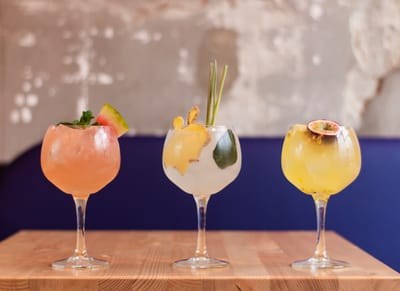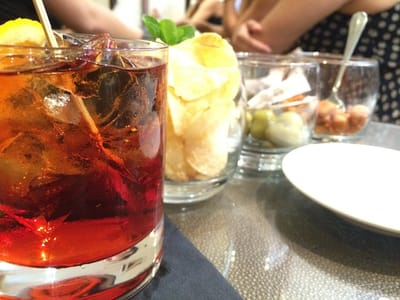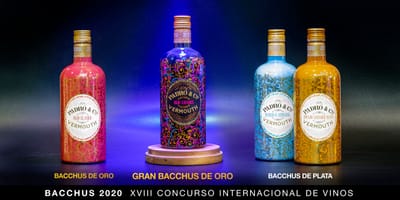The Place
For the European Vermouths
NEW
Vermouths & Apéritifs
The Aperitif
The Aperitif:
The French have perfected this informal practice of pre-dinner drinks and snacks: the aperitif.
In order to stimulate the appetite before dinner, the aperitif in France is almost always accompanied by snacks or finger-food, that is stuff you can eats by hand.
Nothing too much that fills our stomachs, but just enough to want to repeat.
The colloquial form of the word aperitif, l'apéro, referring to this appetite-prone drink, is used to denote this time of day-night exchange.
In short, the apéro is much more than just a pre-dinner aperitif - it comes in and properly celebrates the early evening.
Derived from the Latin verb aperire, aperitif means "to open" both the appetite and the night ....
The format of the aperitif is versatile: served without expecting a meal to follow or as preparation for a dinner, as a quick reset at home before leaving for the restaurant, or as a main event combining some recipes to build a complete meal. known as apéro dînatoire.
Whether served at home, in a bar or in a restaurant, the aperitifs are taken daily with a set of people, whether they are family or friends, or alone on a terrace with a good book.
L 'aperitif is easy to drink thanks to its low alcohol content and is designed to arouse the appetites rather than overwhelming anyone with alcohol and risking a hangover.
L 'apéro is where boyfriends meet after work.
This is where the new movies are hotly debated, where flirt blooms and friends squeeze together around a too-small table where they laugh and take selfies from any angle.
This is where parents and children drink wine and juice and talk about what to do for dinner and where certain people learn how to be alone, ultimately happy with their choices.
This is where revolutions are born over just one more drink.
The apéro is magic
Taken between 6 pm and dinner time, a meal can last from 30 minutes to 1, 5 hours.
DO YOU KNOW THAT ...
APÉRITIFS WITH QUININE....
APÉRITIFS WITH GENTIANE ....
PASTIS ....
The various types of Apéritifs
Before the era of modern medicine, the defense against malaria was the quinine, extracted from the bark of Cinchona in South America. In the 1830s, the French government offered incentives to anyone who could mask the bitter taste of the quinine to encourage its soldiers from the French Foreign Legion in North Africa to drink and thus protect themselves from malaria.
Read MoreThe gentian has bright yellow flowers, a wrinkled root system that seems to come directly from the film "Pan's Labyrinth" by director Guillermo del Toro, and grows in the mountainous regions of France and Switzerland.
Read MoreThe Vermouth
The vermouth was never invented for the purpose of mixing it into a Manhattan or martini, although the addition of vermouth - sweet in a Manhattan and dry in a martini - is essential for each of these cocktails.
In fact, the vermouth was created as a medicinal tonic and is complex enough to be served as a cocktail by itself.
HOW IS VERMOUTH PRODUCED?
Vermouth is a fortified and flavored aperitif wine.
This means that the base is wine, the first element, which is fortified with a neutral spirit such as a grape brandy.
The addition of this alcohol stops the wine fermentation and creates a stronger, sweeter alcohol. This mixture is then infused or flavored with plants.
Each style of vermouth (and it varies greatly from country to country or region to region) has a different, and often secret, blend of herbs, barks, fruits and spices, botanicals such as bitter orange, cardamom, juniper, cinnamon, chamomile, cloves, vanilla and more.
But the most important part without which a vermouth is not a vermouth is the absinthe, which is also the origin of the vermouth name derived from the German word WERMUT.
WHICH WINE IS USED TO PRODUCE A VERMOUTH?
Traditional vermouths start with a white wine base and use colorants to get a deep red color, while some of the new vermouth makers have tried it with red wine.
VERMOUTH HISTORY (the various styles)
The first commercial vermouths were introduced in 1786, in northern Italy, more precisely in Turin, where António Benedetto Carpano produced and started selling on the local market his first aperitifs with medicinal properties.
This formula, initially known simply as "vermouth" and often believed to be the apéritif, was reddish in color, rich and pleasantly sweet.
It was later designated Rosso (red in Italian) or "Sweet" when a new dry vermouth style emerged, created at west of the Italian border in Marseille, France in 1813. This new formula, NOILLY PRAT, created by Joseph Noilly for the first dry vermouth continues today very present, in contrast to the Italian sweet vermouth: floral and dry straw color.
A little further north, in the late 19th century, in Chambéry, DOLIN wins a remarkable place by creating the third style of vermouth, the BLANC, also known as BIANCO or White Vermouth.
The Italians complain that their GANCIA BIANCO was the first of the white vermouths .... but what matters, for a bartender, is that Italian BIANCOs tend to be fatter than the French BLANCs.
Regardless of their background, Blanc's botanists stick with the Sweet ones: vanilla, orange peel and verbena lemon.
It is also the sweetest of the three classic styles, containing almost twice the sugar found in a Dry vermouth and a less peppery flavor than in a Sweet vermouth.
Today, almost all traditional vermouth producers make some kind of rosso and dry vermouth, and many also produce a white vermouth.
There are other products on the market but it is generally fair to say that French producers are best known for their lighter, drier vermouth, and Italian producers are best known for their Torino-inspired spice vermouth, but all comercial vermouth ingredients are still proprietary formulas, and it is their secret botanical and vegetable ingredients as well as their flavor profiles that set them apart.
Some may be better, some worse, although even those recognized among the “best” may not be the best under all circumstances.
It is particularly important not to fall into the trap of comparing vermouths following some Platonic ideal: no, it is more reasonable to expect each vermouth of each style to offer something different that reveals its DNA.
Like Gins or Whiskys, they don't all taste the same .....
We are all unique just like all vermouths, whatever their country or region of origin.
HOW TO DRINK A VERMOUTH
A vermouth can be served without restriction as it should be during an apéro.
But before mixing it with something try to enjoy it just as it comes out of the bottle: straight, with 1 or 2 ice cubes and a zest of citrus, orange for a "Sweet" vermouth, lemon for a "Dry" and grapefruit for a "Blanc" vermouth.
HOW TO STORE VERMOUTH
A bottle of vermouth should be refrigerated after opening it and will remain ok for a month or two.
Use vermouth that is on his end of live for cooking, but like cooking with wine, use it only if you are able to still drink it. So always taste it before and if it is passed throw it away.
Remember that even chilled flavors of vermouth will change, so drink it quickly.
The Amaro
Millennia ago, the ancient Greeks and Romans turned to mixtures of aromatic and botanical roots for medicinal purposes, but the origins of amaro as we know it today can be traced back to medieval friars and monks in abbeys and monasteries across Italy, whose interest by alchemy and the unique restorative properties of herbs and botanicals led them to create bitter tonics.
These secret formulas were preserved in wine or alcohol and used as an elixir to stimulate appetite and aid digestion.
Broadly speaking, amaro refers to the class of aromatic, herbal and bittersweet liqueurs produced in Italy, traditionally served as a digestif after a meal.
Amaros are created by steeping and/or distilling bitter husks, herbs, seeds, spices, citrus rinds, flowers and other herbs in a neutral alcohol or wine that is sweetened with a sugar syrup.
Most amaros are then allowed to rest for a period of time to help further balance the blend and some also spend months or even a year of additional aging in barrels for added complexity.
Common bittering agents used to produce amaro include cinchona bark, gentian root, wormwood, and angelica root, along with additional ingredients ranging in number from a dozen to over forty that may include herbs and spices such as cardamom, chamomile, rhubarb. , mint, orange peel, fennel, artichoke, licorice, eucalyptus, juniper, ginger, thistle, cloves, anise, saffron and sage.
Typically with an alcohol volume between 16º and 40º, the bitterness scale can range from syrupy sweet to more than dry, with a variety of flavors from bright citrus to floral, vegetable, woody, minty and medicinal.
While Italy is the birthplace of amaro and home to the largest selection of what is commercially available, the practice of serving a spirit closer to the end of a rich meal is not strictly an Italian affair.
Technically, a digestive might be a glass of cognac, port, brandy, schnapps or even whiskey, but bittersweet herbal liqueurs that are supposed to aid digestion and well-being have been produced in Western and Central Europe for centuries:
there are, for example, Underberg and Jägermeister in Germany, Gammel Dansk in Denmark, Unicum in Hungary, Becherovka in the Czech Republic; and there are flavored and fortified aperitif wines such as Suze and Bonal in France, among many other brands.
So Amaro serves two purposes: the aperitif and the digestive.
The French Way
As an apéritif or in Cocktails
Stay tuned for new arrivals
The Contact
- Rua das Fisgas, 442
- Parque Cascais Stock -Armazém 6 2645-117 Alcabideche
- +351 21 3624606
- info@wine-time.biz
- 09-13 / 14-18
The Events
THE NATIONAL APÉRITIF DAY, a day organized by Vermuteria Portuguesa, will bring together all apéritif And vermouth brands that want to participate. The event will be held in a public space open to everyone; the idea is to introduce the Mediterranean culture of the aperitif in Portugal, which after all, is the European country with the most days of sunshine a year and whose terraces flourish our sidewalks. At the end of the aperitif, at dinner time, the brands will make the switch for the preparation of cocktails with vermouth exclusively, which after all is the other use of these fabulous wine-based drinks.Read More
- Date: 19-03-2020 17:00 - 19-03-2020 12:00
- Location: Lisbon, Portugal (Map)
- More Info: To be defined
Read More
The Jobs
Horeca Salesman
Do you have a list of clients looking for exceptional and top quality products?
So this job is for you, submit your cv detailing your recent professional background and tell us what motivates you to work with us.
Requirements
Age from 23 to 55 years
Fluent in Portuguese and English languages
Resident in Lisbon
Bonuses
About



VERMUTERIA PORTUGUESA is a registered trademark belonging to WINE-TIME EUROPE Lda (www.wine-time.biz) a company specialized in the import and the Distribution of fine alcoholic beverages (wines, champagnes, vermouths, liqueurs and spirits).
Over the years Wine-Time Europe has foreseen a growth in the area of vermouths and apéritifs due to the growth of foreigners living in Portugal and by the thousands of occasional visitors, all bringing with them the culture from their countries, namely those from Southern Europe, who did not dispense with their apéritif.
Thus the desire to push this culture was born, taking advantage of the opening of terraces on all the sidewalks available in Portugal and thus providing yet another source of revenue for the specialists of the Horeca channel.
Today we can affirm that, although still a beginner, the notion of the aperitif is already well established and we can affirm that the vermouths are not only used in the mixology for famous cocktails such as Negroni or Manhattan.
Here at Vermuteria Portuguesa, we wanted to create a virtual space where Vermouth and Aperitifs lovers can find what is best in this category of old but so current drinks.
Information about Wine-Time Europe Lda
WINE-TIME EUROPE LDA
Rua das Fisgas 442 - Parque Cascais Stock - Armazém 6
2645-117 Alcabideche
Portugal
Tel: +351 21 362 4606
NIF: PT507842219
EXCISES: PT01507842219
WAREHOUSE: PT50784221901
Articles
MARCH 2020 BY PADRÓ & CO. - NEWS Rojo Amargo da Padró & Co., awarded with the maximum recognition of the contest, was the only vermouth that was positioned among the 25 best wines in the world. Four Premium vermouths from the Padró i Família winery were awarded at the 18th edition of the International Bacchus Wine Competition, which took place at the Casino of Madrid, from March 5 to 9, 2020.
Read More





